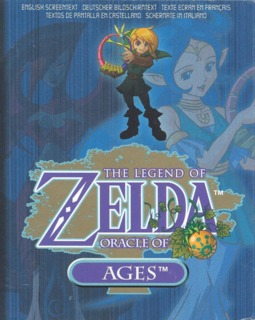Oracle of Seasons is the second act of the Oracle duo (or first, depending on which order you play them in), and much of what I said about Ages could be copied and pasted right here. But I won’t do that. Seasons, although not as good as Ages, is such a wonderful game in its own right that it wouldn’t feel right without giving this review some careful consideration.
Much like Ages the game starts out with a scene depicting the Triforce telling Link that another land is in need of his help, and who better to send than the saviour of Hyrule? This new land is called Holodrum, and it is under threat from the evil General of Darkness, Onox. As the game opens Link comes across a crowd of people watching a girl dance. The girl turns out to be Din, the Oracle of Seasons, who manages to get Link to dance with her. But the dancing gets interrupted when Onox shows up, attacks Link and the crowd, and takes Din to his castle. Link’s objective? To put a stop to Onox and return Holodrum to the peace it previously knew.
While the story of Seasons plays out a lot like that of Ages, but the biggest difference between the two is that Seasons deals with Link having to master the four seasons, winter, spring, summer and autumn, by controlling the Rod of Seasons, unlike Ages which seem him travel through time. The mechanic of changing seasons is handled in the same manner as travelling through time, with the Rod of Seasons being limited in it’s power at first but expanding as the game progresses and as it can control more seasons. Changing the seasons strategically is a must at times, as in summer a tree may block your way while in winter it has withered to a point where Link can pass by. Little things like this are found throughout Seasons, so mastering the seasons is one of the key elements of the game.
Just like Ages the main plot of Seasons sees Link battle is way through eight dungeons, this time to receive the eight Essences of Nature. Like the Essences of Time in Ages the Essences of Nature in Seasons are needed to stop Onox, and just like in Ages the dungeons themselves are all designed fantastically well. But the puzzles in Seasons aren’t quite as involving as in Ages, because while Ages is more puzzle orientated Seasons is more combat orientated. As a result Seasons doesn’t challenge you mentally as much as Ages but it certainly challenges your reflexes more. Seasons is a lot harder, and is actually one of the most difficult games in the series when it comes to combat. The bosses are difficult, but a few rank as some of the hardest in the series. Notably, one of them may very well be more difficult than both the Thunderbird and Dark Link from Zelda II: The Adventure of Link, which some fans may find hard to believe. But it’s true, it really was that much of a challenge.
But just like Ages, which still has some challenging combat, Seasons will still put your mind to the test at times. Although combat is certainly more of a premise the puzzles are still enjoyable even if they aren’t as involving as the ones found in Ages.
One thing that I neglected to mention in my review for Ages, but which is available in both games, is the inclusion of additional help from three new sub characters. But these characters themselves aren’t humans, they are all animals that can traverse areas of the world that Link can’t. The first is Ricky the Kangaroo, who has the power to scale mountains and cliffs with ease thanks to his superior jumping abilities. The second is Dimitri the Dodongo, who has the ability to travel across even the harshest of waters because of his swimming strength. And the third is Moosh the Bear, who has the ability to carry Link across large gaps that would be otherwise impossible to pass thanks to the wings he has. Link will require the help of these characters at least once in both games, but they can all be called at will once the player find their respective flutes. As the game progresses, and as Link finds more items, these characters eventually start to lose their usefulness, but for the most part they offer essential help in exploring every nook and cranny of both Holodrum and Labrynna.
As stated in my review for Oracle of Ages both Ages and Seasons can be linked up via a password to form a double quest. As I said previously it doesn’t matter which you start with first, but I would recommend Ages purely because it will better ready you for the challenges found in Seasons.
Oracle of Seasons comes as highly recommended as Ages, and is a fantastic game whether played by itself or as a linked title. I can’t really say much more that I haven’t already covered in my Ages review. By now you have probably guessed both are certainly must own games, and both are amongst the best games available for the Game Boy Colour.
Pros:
- Great dungeons
- A challenge even for more veteran Zelda fans
- Linking up with Ages adds extra mileage to an already solid title
- Just as good as any Nintendo developed Zelda title
Cons:
- Some slight control issues
Score: 9.5
Review by James Widdowson

